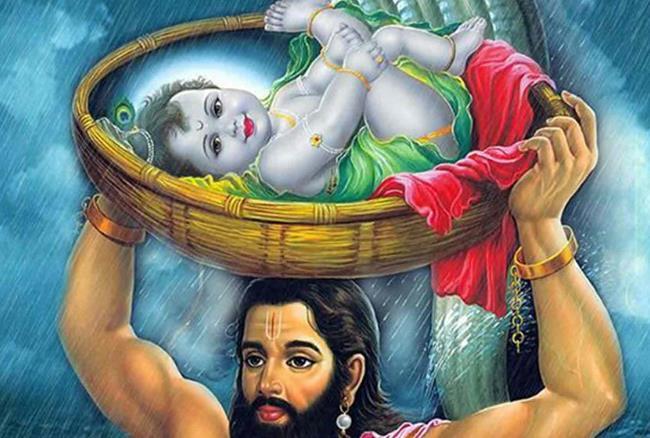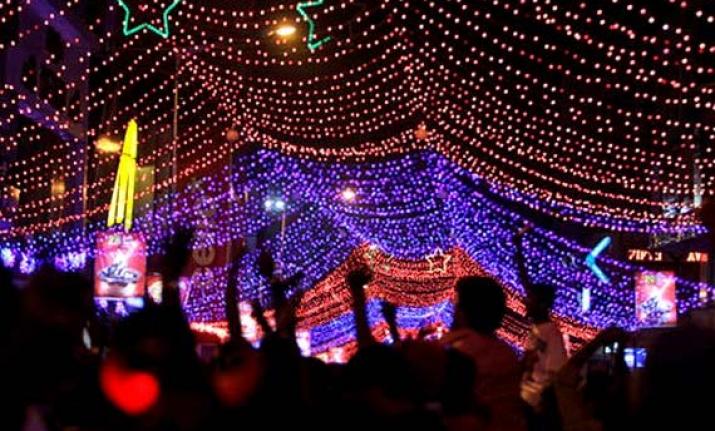
India is a land steeped in festivals, a rich tapestry woven with diverse traditions and beliefs. Among the myriad gods and deities revered here, Krishna stands out as a radiant figure — a symbol of allure, joy, and inspiration. He beckons us to embrace life’s challenges with our utmost efforts and to unburden ourselves from the weight of outcomes.
Krishna’s persona is one of captivating beauty and enchantment. His image radiates an innate charm that draws people towards his teachings and stories. Through his playful demeanor and mischievous exploits as a child, Krishna conveys the message that life should be lived joyfully, with a spirit of mirth and enthusiasm.
What is Janmashtami?
Janmashtami is a vibrant festival that joyously commemorates the birth of Lord Krishna, the eighth incarnation of Lord Vishnu in Hinduism. This auspicious occasion marks the arrival of Lord Krishna into the world, and it is celebrated with fervor and devotion by millions of devotees.
The festival holds a special place in the hearts of devotees, who eagerly anticipate its arrival each year. Temples and homes are adorned with intricate decorations, and the air is infused with the sweet scent of incense and the melodies of devotional songs. As the clock strikes midnight, the atmosphere is charged with an electric energy, akin to the joyous anticipation that heralded Lord Krishna’s birth.
Elaborate rituals, pujas (worship ceremonies), and bhajans (devotional songs) resonate throughout the night, paying homage to the divine grace that Lord Krishna brought to the world. Delightful reenactments of his childhood pranks and legendary tales, such as the lifting of Govardhan Hill and the enchanting Raas Leela dance, are performed with great zeal.
Devotees often observe fasts on this sacred day, breaking them only at the precise moment when Lord Krishna is believed to have been born. Feasts are prepared with an array of delectable sweets and dishes, symbolizing the abundance that Lord Krishna’s presence brings into the lives of his devotees.
Janmashtami transcends geographical boundaries, uniting hearts across the world in a shared celebration of spirituality and devotion. It serves as a reminder of Lord Krishna’s teachings that emphasize the importance of righteousness, selfless action, and unwavering devotion.
In the embrace of Janmashtami’s fervor, devotees find solace and inspiration. It is a time to reflect on the timeless wisdom imparted by Lord Krishna and to seek his blessings for a life filled with love, joy, and spiritual awakening.
Krishna as the role modal of society
The life of Lord Krishna stands as a flawless illustration of unwavering dedication to serving others and a profound detachment from concerns over outcomes. Throughout his earthly journey, Krishna illuminated the path of righteous action and exemplified the essence of laboring diligently for the betterment of all, while letting go of preoccupations about results. His philosophy revolved around embracing the true potency of hard work as the sole conduit to achieving success.
Lord Krishna’s life was a canvas painted with selfless deeds and altruistic endeavors. He fervently embraced his roles and responsibilities, whether as a caring friend, a devoted brother, or a wise counselor. His actions were guided by an unshakable commitment to righteousness and the welfare of society.
The narrative of the Bhagavad Gita, a spiritual dialogue between Krishna and Arjuna, beautifully encapsulates this philosophy. Krishna encouraged Arjuna to fulfill his duty as a warrior without allowing his mind to be clouded by the uncertainty of consequences. He stressed the significance of action performed with sincerity and devotion, rather than the attachment to potential results.
Krishna’s belief in the supremacy of hard work transcended the confines of time. His wisdom continues to illuminate the path of humanity, reminding us that our efforts pave the way for progress. Just as he guided Arjuna on the battlefield, Krishna’s teachings guide us through the complexities of life, urging us to channel our energies into dedicated action while freeing ourselves from the binds of anxiety.
Krishna’s Flute-Symbol of Harmony & Rhythm
Krishna’s flute, a symbol often associated with him, represents the harmony and rhythm of life. Its mellifluous tunes resonate with the idea that we should engage in our roles with a sense of balance, never becoming entangled in the complexities to the point of losing sight of the joyous essence of existence.
Krishna as a Saviour in Mahabharata
He was the companion of Arjun in the major fight of his life in Mahabharata battle. Arjuna was in the dilemma whether he should fight against his own brother and uncles or not. It was Krishna only who came as his saviour and gave him Geeta Updesh, following which Arjuna finally agreed to fight for the truth.
It was Krishna only who saved Draupadi from being humiliated in-front-of Kaurawas during her cheer-haran when Pandavas lost her to them. There are many such incidences where Krishna saved his devotees and set-up example in the society.
Why Krishna was born in a prison?
It’s said that many years back of dwarpar yug, Kansa was the ruling king of Mathura. He had a sister Devki who was very adorable to him. He married him off to Vasudeva on a large scale with a lot of magnificence.
Kansa was very happy in the marriage but suddenly the cloud roared and forecast with a prophecy that the eighth son of Devaki and Vasudeva would be the cause of his death.
On hearing this, Kansa put the newly married couple into the prison or Karaghar. Devaki gave birth to six children and Kansa killed all of them by one by. He would throw them on to the wall that resulted into their death. The seventh child of Devaki was mystically transferred to the womb of Princess Rohini in Vrindavan, and Kansa was told that Devaki had a miscarriage. This child got famous with the name of Balram to the world.
When Devaki was again pregnant with her eighth child which would be the cause of death for Kansa as per the prophecy, Kansa got frightened. The destiny played its role and there was dark and thundercloud with heavy rain when Krishan was about to born. Vasudeva was guided by the gods and was told to take the child to Vrindavan to the house of Yasoda and Nanda. With god grace the whole Mathura was sleeping and Vasudeva took a basket, put the child into it with fully covered and started following the god’s voice. He crossed the Yamuna river with the basket on his head under heavy thunderstorms and rain.
The Shesh nag in the river Yamuna helped Krishna to reach Vrindavan. In Vrindavan Yasoda was also expecting a child that time, Vasudav exchanged her newly born daughter with little Krishna. He took the daughter back to Mathura and the news of a girl child born was given to Kansa. Vasudeva thought he would not harm the girl child as according to the prophecy only the eight sons would be the cause of death of Kansa but he was a merciless king. He took the girl child and was about to throw her to kill. Suddenly she took the form of Goddess Durga, warning him that the eighth son had already taken birth and his death is certain by him.
The little Krishna was grown up in Vrindavan by Nanda and Yashoda and years after became the cause of Kansa death.
Janamashtmi Celebrations and Rituals
On the day of Janamashtmi, temples are decorated with beautiful flowers and lights and a palna or jhoola of Radha-Krishna is made. People observe fast and do chanting and worship of the god all the day. There are many bhajan, kirtans, dances and other activities performed in temples.
People visit temples and offer bhog and prasadam to their beloved deity. The idol of Krishna is given a bath with milk, ghee, honey and water followed by dressing it with new clothes. The special bhog offered to Krishna is of Makhan Mishri – as he was a great lover of makhan.
In temples, people gather and sing songs in the name of lord Krishna and dance with full energy and dedication. Devotees also make a list of 56 food items, called “Chappan Bhog”. This Chappan bhog is distributed among the devotees after the final aarti in the mid-night. They go back to their home and open their fast by eating saatvik food.
The lord Krishna is famous with many names like, Kanha, Nand Kishore, Nand Gopal, Makhanchor, Yashoda Nandan, Giridhar, Ladoo Gopal etc.
Matki-Phod Traditions during Janmashtami
A remarkable highlight of Janmashtami celebrations is the “matki-phod” tradition. In various places, spirited competitions known as “matki-phod” are organized, wherein teams enthusiastically attempt to break a suspended pot filled with butter or curd. This playful reenactment pays homage to the childhood antics of Lord Krishna, who was known for his mischievous escapades of stealing butter. The victorious team that manages to break the pot is rewarded, adding a joyous and competitive spirit to the festivities.
Famous temples of Lord Krishna
The devotion to Lord Krishna transcends geographical boundaries, with numerous temples erected worldwide in his honor. Even beyond the borders of India, people are profoundly drawn to the charisma of Lord Krishna. Among these sacred places, the renowned ISKCON temples hold a prominent position, drawing multitudes of devotees. On Janmashtami, the festivities at these temples witness an immense influx of devotees, and the dedicated volunteers guide these pilgrims through the serpentine queues, ensuring they have a seamless experience.
Two cities in India, Mathura and Vrindavan, hold a special place in the heart of Janmashtami celebrations. Mathura, the birthplace of Lord Krishna, and Vrindavan, where he spent his formative years under the care of Nanda and Yasoda, resonate with fervent devotion during this time. Elaborate aartis (ceremonial rituals), soul-stirring bhajans (devotional songs), and vibrant festivities unfold in these sacred lands, immersing devotees in the divine aura of Lord Krishna’s birth and upbringing.



